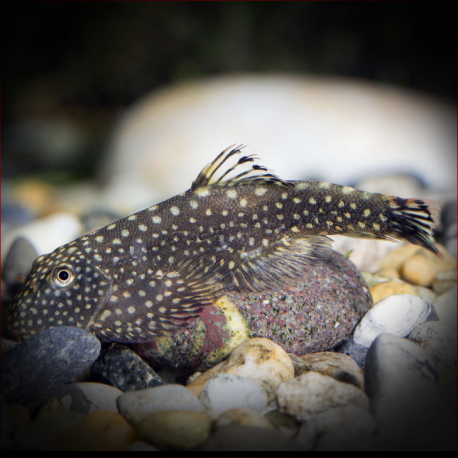More info
Datasheet
| Minimum Tank Size | 90 litres / 23.78 US gallons |
| Maximum Size | 4.5cm / 1.77inches |
| Temperature | 20°C / 68.00°F - 24°C / 75.20°F |
| Hardness | 1.01dgH / 18ppm - 12.05dgH / 215ppm |
| pH | 6.0-7.5 |
General Description
Gastromyzon scitulus, commonly known as the Borneo Sucker or Butterfly Loach, is a peaceful species with distinctive cream spots on its body, pelvic, and pectoral fins. This species is a member of the family Gastromyzontidae and is adapted to life in fast-flowing waters, featuring a flattened body and horizontally oriented fins that form a powerful sucking cup allowing it to cling to solid surfaces.
Aquarium Setup
The optimal tank setup for Gastromyzon scitulus includes clean, well-oxygenated water with a turnover rate of 10-15 times per hour. It is recommended to use gravel or sand substrate, along with water-worn rocks, pebbles, and aged driftwood. Artificial lighting should be strong to promote algae growth, which is an essential part of their diet. Aquatic plants like Microsorum and Anubias spp. can be added, providing additional cover and attracting algal growth. A tightly-fitting cover is necessary, as these loaches can climb glass.
Behaviour
Gastromyzon scitulus displays peaceful behavior but can be territorial to some extent, especially around prime feeding spots. They tend to exist in loose aggregations and may exhibit varying levels of territoriality among individuals. The species is adapted for life in fast-flowing water, positioning themselves facing the flow to forage and maintain specific spots without getting swept away.
Feeding and Diet
In their natural habitat, Gastromyzon scitulus feeds on benthic algae and micro-organisms. In captivity, they accept dried foods, live or frozen bloodworms, and homemade gelatin-bound mixtures tailored with fresh vegetables and Spirulina. A mature aquarium with ample algae-covered surfaces is crucial for their long-term health.
Reproduction & Dimorphism
Reproduction in Gastromyzon scitulus involves spawning behaviors induced by changes in water temperature and feeding. Females are typically heavier-bodied and slightly larger than males. Successful breeding has been reported in captivity, with fry requiring small infusoria-type diets initially.
Habitat and Distribution
Endemic to Borneo, Gastromyzon scitulus is found in tributaries of the Sungai Sadong basin in southern Sarawak, Malaysia. They inhabit swift, shallow streams with clear, oxygen-saturated water, preferring substrates of gravel, rocks, or bedrock covered in algae. The species is restricted to specific river basins in Borneo, showcasing specialized morphological adaptations for their unique habitat.

